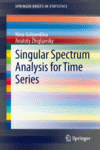| 1 | Introduction | 1 |
| | 1.1 Preliminaries | 1 |
| | 1.2 SSA Methodology and the Structure of the Book | 3 |
| | 1.3 SSA Topics Outside the Scope of This Book | 6 |
| | 1.4 Common Symbols and Acronyms | 8 |
| 2 | Basic SSA | 11 |
| | 2.1 The Main Algorithm | 11 |
| |
2.1.1 Description of the Algorithm
| 11 |
| |
2.1.2 Analysis of the Four Steps in Basic SSA
| 13 |
| | 2.2 Potential of Basic SSA | 19 |
| |
2.2.1 Extraction of Trends and Smoothing
| 19 |
| |
2.2.2 Extraction of Periodic Components
| 21 |
| |
2.2.3 Complex Trends and Periodicities
with Varying Amplitudes
| 22 |
| |
2.2.4 Finding Structure in Short Time Series
| 23 |
| |
2.2.5 Envelopes of Oscillating Signals and Estimation of Volatility
| 24 |
| | 2.3 Models of Time Series and SSA Objectives | 25 |
| |
2.3.1 SSA and Models of Time Series
| 25 |
| |
2.3.2 Classification of the Main SSA Tasks
| 35 |
| |
2.3.3 Separability of Components of Time Series
| 37 |
| | 2.4 Choice of Parameters in Basic SSA | 39 |
| |
2.4.1 General Issues
| 39 |
| |
2.4.2 Grouping for Given Window Length
| 43 |
| |
2.4.3 Window Length
| 47 |
| |
2.4.4 Signal Extraction
| 53 |
| |
2.4.5 Automatic Identification of SSA Components
| 54 |
| | 2.5 Some Variations of Basic SSA | 58 |
| |
2.5.1 Preprocessing
| 58 |
| |
2.5.2 Centering in SSA
| 59 |
| |
2.5.3 Stationary Series and Toeplitz SSA
| 60 |
| |
2.5.4 Rotations for Separability: SSA–ICA
| 61 |
| |
2.5.5 Sequential SSA
| 65 |
| |
2.5.6 Computer Implementation of SSA
| 67 |
| |
2.5.7 Replacing the SVD with Other Procedures
| 68 |
| 3 | SSA for Forecasting, Interpolation, Filtration and Estimation | 71 |
| | 3.1 SSA Forecasting Algorithms | 71 |
| |
3.1.1 Main Ideas and Notation
| 71 |
| |
3.1.2 Formal Description of the Algorithms
| 73 |
| |
3.1.3 SSA Forecasting Algorithms: Similarities and Dissimilarities
| 75 |
| |
3.1.4 Appendix: Vectors in a Subspace
| 77 |
| | 3.2 LRR and Associated Characteristic Polynomials | 78 |
| |
3.2.1 Basic Facts
| 78 |
| |
3.2.2 Roots of the Characteristic Polynomials
| 79 |
| |
3.2.3 Min-Norm LRR
| 80 |
| | 3.3 Recurrent Forecasting as Approximate Continuation | 83 |
| |
3.3.1 Approximate Separability and Forecasting Errors
| 83 |
| |
3.3.2 Approximate Continuation and the Characteristic Polynomials
| 84 |
| | 3.4 Confidence Bounds for the Forecast | 86 |
| |
3.4.1 Monte Carlo and Bootstrap Confidence Intervals
| 87 |
| |
3.4.2 Confidence Intervals: Comparison of Forecasting Methods
| 89 |
| | 3.5 Summary and Recommendations on Forecasting Parameters | 90 |
| | 3.6 Case Study: ‘Fortified Wine’ | 94 |
| |
3.6.1 Linear Recurrence Relation Governing the Time Series
| 94 |
| |
3.6.2 Choice of Forecasting Methods and Parameters
| 96 |
| | 3.7 Missing Value Imputation | 98 |
| |
3.7.1 SSA for Time Series with Missing Data: Algorithm
| 99 |
| |
3.7.2 Discussion
| 102 |
| |
3.7.3 Example
| 102 |
| | 3.8 Subspace-Based Methods and Estimation
of Signal Parameters | 104 |
| |
3.8.1 Basic Facts
| 105 |
| |
3.8.2 ESPRIT
| 106 |
| |
3.8.3 Overview of Other Subspace-Based Methods
| 108 |
| |
3.8.4 Cadzow Iterations
| 110 |
| | 3.9 SSA and Filters | 111 |
| |
3.9.1 Linear Filters and Their Characteristics
| 111 |
| |
3.9.2 SSA Reconstruction as a Linear Filter
| 112 |
| |
3.9.3 Middle Point Filter
| 113 |
| |
3.9.4 Last Point Filter and Forecasting
| 116 |
| |
3.9.5 Causal SSA (Last-Point SSA)
| 116 |
